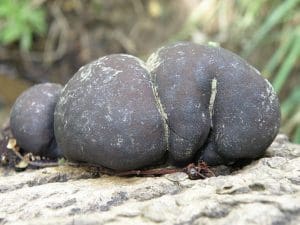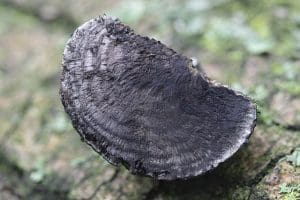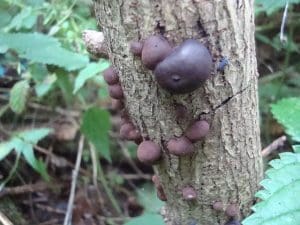King Alfred Cakes / All Year Round / Inedible
Enter the realm of nature’s charred artistry as we appreciate the unique presence of the King Alfred Cakes (Daldinia concentrica).
Join us on a journey where curiosity meets knowledge. With its distinctive black, coal-like appearance and concentric rings, the King Alfred Cakes stand as a testament to the fascinating artistry of fungi. While not suitable for consumption, these charred formations hold their own significance in the natural world.
Learn to identify their unique features, discover their preferred habitats, and delve into their ecological role. Embrace the beauty of nature’s diverse creations as we appreciate the intriguing presence of the King Alfred Cakes.
Let us marvel at their charred artistry while respecting their place within the ecosystem. Acknowledge the importance of accurate identification, responsible exploration, and the preservation of our natural wonders. Stay captivated by the enigmatic allure of the King Alfred Cakes, appreciating their existence as part of the captivating tapestry of the natural world.
Scientific Name
Daldinia Concentrica
Common Names
King Alfred Cakes, Coal Fungus, Carbon Fungus, Cramp Balls
Family
Hypoxylaceae
Habitat
They are saprotrophic and can be found in groups on dead or decaying hardwoods, most often on ash and beech.
Description
An easy to identify mushroom, they are very common in the UK, although not edible they make excellent firelighters and would have been an important resource for our ancestors.
Identifying Features for the King Alfred Cakes:
Cap:
No cap as such, the round or spherical fruiting bodies called stroma have no gills, pores etc. they are also without a stem. The common name ‘Coal Fungus’ is very apt.
When young they are purple-brown in colour but soon turn almost jet black.
They can remain on the tree for many years, each year produce a new layer of growth so that their age can be read like the growth rings on trees. I.e. the bigger the fruiting body the older the fungus.
When they are cut in half you can see these growth rings appearing as concentric circles of black and silver.


Smell:
No real smell.
Spores:
Black.
Uses
When dried they will take a spark from a flint and steel, so they are a really useful bushcraft tool.
Our ancestors would have used them to transport fires, as they will smoulder for hours once lit. There can also be used a bit like a charcoal briquette and apparently, they are taught to the special forces as they don’t produce smoke so help them to remain undetected.
Harvesting
The younger brown bodies are not really useful, you want large, black examples which are lighter and more brittle and they need to be completely dried out before using them for fire lighting. They can live on the host year for many years but grow between spring and autumn.
Also, they will produce their spores for a long time after they’ve been picked and leave a ‘sooty’ mark so be careful where you store them.

Potential lookalikes
There are a few similar black, crusty fungus’ growing on dead wood. The Brittle Cinder Fungus (Kretzschmaria Deusta) does not form ball-shaped fruit bodies and when cut in half doesn’t have the concentric pattern of rings.
Maybe Horse Hoof Fungus which has a flat bottom side
Extra Notes
The common name King Alfred Cakes is said to come from the time when King Alfred was hiding from the Danes, he was given shelter by a woman and he promised to keep an eye on her cakes in return He forgot all about the cake and they burned. It is said he then scattered them throughout the forest to hide his mistake!
The name Cramp Ball comes from the belief that carrying them in your pockets relieves cramp.
I’ve used the spores from this mushroom for making incredibly fine black ink in the past, the micron size of the spores is absolutely tiny and therefore produces an incredibly fine and easy to use black ink. To Collect the spores I picked them before sporulating, laid them on paper until they sporulated and dropped their spores on the paper. I then mixed these spores with water and gum arabic (the gum from a cherry tree would work too) to create the ink 🙂
Leave a Reply
You must be logged in to post a comment.







2 replies on “King Alfred Cakes (Daldinia Concentrica)”